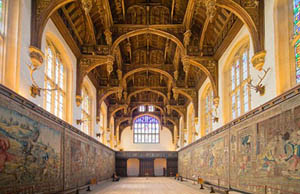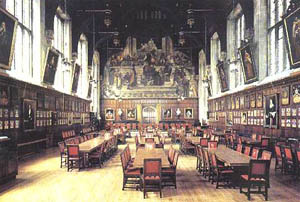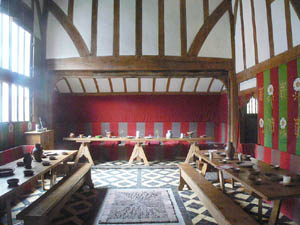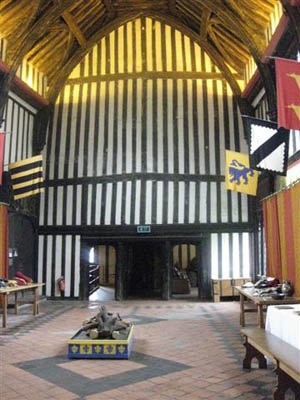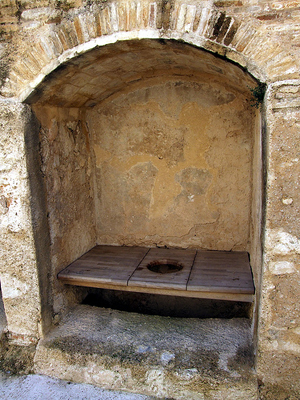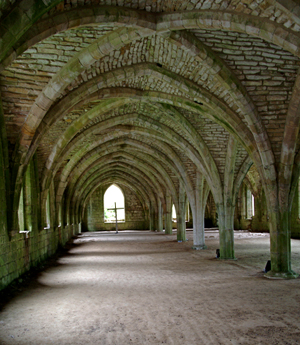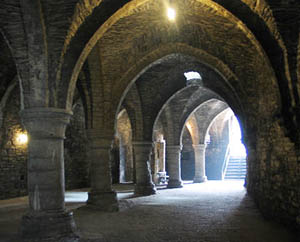 |
 |
 |
 |
 |
 |
|
|
|
|
Rooms in a Medieval Castle
Rooms in a medieval are largely recognisable by their modern counterparts
in more modest homes. Kitchens are still kitchens. So are pantries
and larders. So are cellars. Bed chambers are now known as bedrooms.
Latrines have become lavatories and bathrooms. Halls have morphed
into entrance halls and dining rooms have taken over one of their
main functions. Solars, Cabinets and Boudoirs have become sitting
rooms, libraries and dressing rooms. Ice houses have been replaced
by refrigerators.
Below are the main rooms found in medieval castles and large manor
houses.
|
| Bower at Smithills |
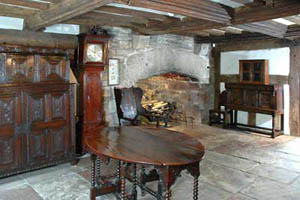 |
| |
| |
| |
| |
|
|
|
The Great Hall
A great hall is the main room of a royal palace, nobleman's castle
or a large manor house in the Middle Ages, and in the country houses
of the 16th and early 17th centuries. Great halls were found especially
in France, England and Scotland, but similar rooms were also found
in some other European countries.
In the medieval period the room would simply have been referred
to as the "hall" unless the building also had a secondary hall,
but the term "great hall" has been predominant for surviving rooms
of this type for several centuries to distinguish them from the
different type of hall found in post-medieval houses.
A typical great hall was a rectangular room between one and a half
and three times as long as it was wide, and also higher than it
was wide. It was entered through a screens passage at one end, and
had windows on one of the long sides, often including a large bay
window. There was often a minstrel's gallery above the screens passage.
At the other end of the hall was the dais where the top table was
situated. The lord's family's more private rooms lay beyond the
dais end of the hall, and the kitchen, buttery and pantry were on
the opposite side of the screens passage.
Even the royal and noble residences had few living rooms in the
Middle Ages, and a great hall was a multifunction room. It was used
for receiving guests and it was the place where the household would
dine together, including the lord of the house, his gentleman attendants
and at least some of the servants. At night some members of the
household might sleep on the floor of the great hall. From time
to time it might also serve as the lord's courtroom.
The great hall would often have one of the larger fireplaces of
the palace, manor house or castle, frequently large enough to walk
and stand inside it. It was used for warmth and also for some of
the cooking, although for larger structures a medieval kitchen would
customarily lie on a lower level for the bulk of cooking. Commonly
the fireplace would have an elaborate overmantle with stone or wood
carvings or even plasterwork which might contain coats of arms,
heraldic mottoes (usually in Latin), caryatids or other adornment.
In the upper halls of French manor houses, the fireplaces were
usually very large and elaborate. Typically, the great hall had
the most beautiful decorations in it, as well as on the window frame
mouldings on the outer wall. Many French manor houses have very
beautifully decorated external window frames on the large mullioned
windows that light the hall. This decoration clearly marked the
window as belonging to the lord's private hall. It was where guests
slept.
In western France, the early manor houses were centered around
a central ground-floor hall. Later, the hall reserved for the lord
and his high-ranking guests was moved up to the first-floor level.
This was called the salle haute or upper hall (or "high room").
In some of the larger three-storey manor houses, the upper hall
was as high as second storey roof. The smaller ground-floor hall
or salle basse remained but was for receiving guests of any social
order.[1] It is very common to find these two halls superimposed,
one on top of the other, in larger manor houses in Normandy and
Brittany. Access from the ground-floor hall to the upper (great)
hall was normally via an external staircase tower. The upper hall
often contained the lord's bedroom and living quarters off one end.
Occasionally the great hall would have an early listening device
system allowing conversations to be heard in the lord's bedroom
above. In Scotland these devices are called a laird's lug. In many
French manor houses there are small peep-holes from which the lord
could observe what was happening in the hall. This type of hidden
peep-hole is called a judas in French.
Many great halls survive. Two very large surviving royal halls
are Westminster Hall and the Wenceslas Hall in Prague Castle. Penshurst
Place in Kent, England has a little altered 14th century example.
Surviving 16th century and early 17th century specimens in England,
Wales and Scotland are numerous, for example those at Longleat (England),
Burghley House (England), Bodysgallen Hall (Wales), Muchalls Castle
(Scotland) and Crathes Castle (Scotland).
By the late 1700s the great hall was beginning to lose its purpose.
The greater centralisation of power in royal hands meant that men
of good social standing were less inclined to enter the service
of a lord in order to obtain his protection. As the social gap between
master and servant grew, there was less reason for them to dine
together and servants were banished from the hall. In fact, servants
were not usually allowed to use the same staircases as nobles to
access the great hall of larger castles in early times; for example,
the servants' staircases are still extant in places such as Muchalls
Castle. The other living rooms in country houses became more numerous,
specialised and important, and by the late 17th century the halls
of many new houses were simply vestibules, passed through to get
to somewhere else, but not lived in.
Many colleges at Durham, Cambridge, Oxford and St Andrews universities
have halls on the great hall model which are still used as dining
rooms on a daily basis, the largest in such use being that of University
College, Durham. So do the Inns of Court in London and King's College
School in Wimbledon. The "high table" (often on a small dais at
the top of the hall, farthest away from the screens passage) seats
dons (at the universities) and Masters of the Bench (at the Inns
of Court), whilst students (at the universities) and barristers
or students (at the Inns of Court) dine at tables placed at right
angles to the high table and running down the body of the hall,
thus reproducing the hierarchical arrangement of the medieval household.
From the 16th century onwards halls lost most of their traditional
functions to more specialised rooms, both for family members and
guests (e.g. dining parlours, drawing rooms), and for servants (e.g.
servants halls and servants bedrooms in attics or basements) . The
halls of 17, 18th and 19th country houses and palaces usually functioned
almost entirely as vestibules, even if they were architecturally
impressive. There was a revival of the great hall concept in the
late 19th and early 20th centuries, with large halls used for banqueting
and entertaining (but not as eating or sleeping places for servants)
featuring in some houses of this period as part of a broader medieval
revival, for example Thoresby Hall.
|
|
|
|
|
|
Bed Chambers
The room in the castle called the Lords and Ladies Chamber, or
the Great Chamber, was intended for use as a bedroom and used
by the lord and lady of the castle - it also afforded some privacy
for the noble family of the castle. This type of chamber was
originally a partitioned room which was added to the end of the
Great Hall. The Lords and Ladies chamber were subsequently situated
on an upper floor when it was called the solar.
The lord and lady's personal attendants were fortunate to stay
with their master or mistress in their separate sleeping quarters.
However, they slept on the floor wrapped in a blanket, but, at least
on the floor, they could absorb some of the warmth of the fireplace.
Even during the warmest months of the year, the castle retained
a cool dampness and all residents spent as much time as possible
enjoying the outdoors. Oftentimes, members wrapped blankets around
themselves to keep warm while at work (from which we derive the
term bedclothes).
The lord, his family and guests had the added comfort of heavy
blankets, feather mattresses, fur covers, and tapestries hanging
on the walls to block the damp and breezes, while residents of lesser
status usually slept in the towers and made due with lighter bedclothes
and the human body for warmth.
|
| |
| Viollet-le-Duc's impression of a XIV to XV Century Castle
Bed chamber |
 |
| |
| |
| |
| |
|
|
|
The Solar
The room in the castle called the Solar was intended
for sleeping and private quarters and used by the Lord's family.
It became a private sitting room favoured by the family. The solar
suite of rooms was extended to include a wardrobe.
The solar was a room in many English and French medieval manor
houses, great houses and castles. In such houses a need was felt
for more privacy to be enjoyed by the head of the household, and,
especially, by the senior women of the household. The solar was
a room for their particular benefit, in which they could be alone
(or sole) and away from the hustle, bustle, noise and smells of
the Great Hall.
The solar was generally smaller than the Great Hall, because it
was not expected to accommodate so many people, but it was a room
of comfort and status, and usually included a fireplace and often
decorative woodwork or tapestries/wall hangings.
In manor houses of western France, the solar was sometimes a separate
tower or pavilion, away from the ground-floor hall and upper hall
(great hall) to provide more privacy to the feudal lord and his
family.
The etymology of solar is often mistaken for having to do with
the sun but this is not so. This error may result from the common
usage of the solar; embroidery, reading, writing, and other generally
solitary activities. These activities would need good sunlight,
and it is true that most solars were built facing south to take
maximum advantage of daylight hours, but that characteristic was
neither required nor the source of the name. The name fell out of
use after the sixteenth century and its later equivalent was the
drawing room.
|
| Solar at Kentwell |
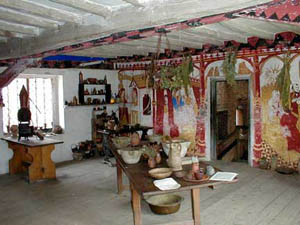 |
| |
| Solar at Smithills, Bolton |
 |
|
 |
|
|
Bathrooms, Lavatories and Garderobes
  Bathrooms,
so common in the classical world disappeared in Medieval Europe
- except in monasteries. Except in certain circumstances baths were
not required for ordinary people - until Victorian times cleanliness
was fundamentally ungodly. Bathrooms,
so common in the classical world disappeared in Medieval Europe
- except in monasteries. Except in certain circumstances baths were
not required for ordinary people - until Victorian times cleanliness
was fundamentally ungodly.
Baths were taken in transportable wooden tubs, In summer the sun
could warm the water and the bather. The tub could be moved inside
when the weather worsened.
Privacy was ensured with a tent or canopy.
In English a garderobe has come to mean a primitive toilet in a
castle or other medieval building, usually a simple hole discharging
to the outside. Such toilets were often placed inside a small chamber,
leading by association to the use of the term garderobe to describe
them.
Technically garderobes were small rooms or large cupboards (closets)
in which the latrine was located. These closets were often used
for storing valuables
A description of the garderobe at Donegal castle indicates that
during the time when the castle garderobe was in use it was believed
that ammonia was a disinfectant and that visitor's coats and cloaks
were kept in the garderobe.
Depending on the structure of the building, garderobes could lead
to cess pits or moats. Many can still be seen in Norman and Medieval
castles and fortifications. They became obsolete with the introduction
of indoor plumbing.
Given the likely updrafts in a medieval castle, a chamber pot generally
remained close to the bedside.
|
|
|
|
|
|
Kitchens, Pantries, Larders and Butteries
In most households, including early castles, cooking was done on
an open hearth in the middle of the main living area, to make efficient
use of the heat. This was the most common arrangement for most of
the Middle Ages, so the kitchen was combined with the dining hall.
Towards the Late Middle Ages a separate kitchen area began to evolve.
The first step was to move the fireplaces towards the walls of the
main hall, and later to build a separate building or wing that contained
a dedicated kitchen area, often separated from the main building
by a covered arcade. This way, the smoke, odours and bustle of the
kitchen could be kept out of sight of guests, and the fire risk
to the main building reduced.
Many basic variations of cooking utensils available today, such
as frying pans, pots, kettles, and waffle irons, already existed
in great households. Other tools more specific to cooking over an
open fire were spits of various sizes, and material for skewering
anything from delicate quails to whole oxen. There were also cranes
with adjustable hooks so that pots and cauldrons could easily be
swung away from the fire to keep them from burning or boiling over.
Utensils were often held directly over the fire or placed into embers
on tripods.
There were also assorted knives, stirring spoons, ladles and graters.
In wealthy households one of the most common tools was the mortar
and sieve cloth, since many medieval recipes called for food to
be finely chopped, mashed, strained and seasoned either before or
after cooking. This was based on a belief among physicians that
the finer the consistency of food, the more effectively the body
would absorb the nourishment. It also gave skilled cooks the opportunity
to elaborately shape the results. Fine-textured food was also associated
with wealth; for example, finely milled flour was expensive, while
the bread of commoners was typically brown and coarse. A typical
procedure was farcing (from the Latin farcio, "to cram"), to skin
and dress an animal, grind up the meat and mix it with spices and
other ingredients and then return it into its own skin, or mold
it into the shape of a completely different animal.
The kitchen staff of huge noble or royal courts occasionally numbered
in the hundreds, including: pantlers, bakers, waferers, sauciers,
larderers, butchers, carvers, page boys, milkmaids, butlers and
scullions. Major kitchens of households had to cope with the logistics
of daily providing at least two meals for several hundred people.
Guidelines on how to prepare for a two-day banquet include a recommendation
that the chief cook should have at hand at least 1,000 cartloads
of "good, dry firewood" and a large barnful of coal.
|
| A cook at the stove with a cook's trademark ladle; woodcut
illustration from Kuchenmaistrey, the first printed cookbook
in German, woodcut, 1485. |
 |
| |
| |
| Kitchen |
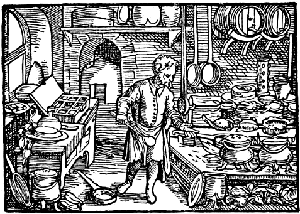 |
|
|
|
|
|
Pantry
A pantry is a room where food, provisions or dishes are stored
and served in an ancillary capacity to the kitchen. The derivation
of the word is from the same source as the Old French term paneterie;
that is from pain, the French form of the Latin pan for
bread.
In a late medieval hall, there were separate rooms for the various
service functions and food storage. A pantry was where bread was
kept and food preparation associated with it done. The head of the
office responsible for this room was referred to as a pantler. .
|
|
|
|
Larder
A larder is a cool area for storing food prior to use. Larders
were commonplace in houses before the widespread use of the refrigerator.
Essential qualities of a larder are that it should be:as cool as
possible, close to food preparation areas, constructed so as to
exclude flies and vermin, easy to keep clean, and equipped with
shelves and cupboards appropriate to the food being stored.
In the northern hemisphere, most houses would arrange to have their
larder and kitchen on the north or east side of the house where
it received least sun.
Many larders have small unglazed windows with the window opening
covered in fine mesh. This allows free circulation of air without
allowing flies to enter. Many larders have tiled or painted walls
to simplify cleaning. Older larders and especially those in larger
houses have hooks in the ceiling to hang joints of meat or game.
Others have insulated containers for ice.
A pantry may contain a a stone slab or shelf used to keep food
cool in the days before refrigeration was domestically available.
In the late medieval hall, a thrawl would have been appropriate
to a larder. In a large or moderately large nineteenth century house,
all these rooms would have been placed as low in the building as
possible, or as convenient, in order to use the mass of the ground
to retain a low summer temperature. For this reason, a buttery was
usually called the cellar by this stage.
In medieval households the larderer was an officer responsible
for meat and fish, as well as the room where these commodities were
kept. . The Scots term for larder was the spence, and so in Scotland
larderers (also pantlers and cellarers) were known as spencers.
This is one of the derivations of the modern surname.
The office only existed as a separate office in larger households.
It was closely connected with other offices of the kitchen, such
as the saucery and the scullery.
|
| Larder |
 |
| |
| Larder |
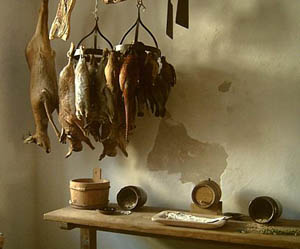 |
|
|
|
Buttery
A buttery was a domestic room in a castle or large medieval house.
It was one of the offices pertaining to the kitchen. It was generally
a room close to the Great Hall and was traditionally the place from
which the yeoman of the buttery served beer and candles to those
lower members of the household not entitled to drink wine.
The room takes its name from the beer butts (barrels) stored there.
The buttery generally had a staircase to the beer cellar below.
The wine cellars, however, belonged to a different department, that
of the yeoman of the cellar and in keeping with the higher value
of their contents were often more richly decorated to reflect the
higher status of their contents.
From the mid-17th century, as it became the custom for servants
and their offices to be less conspicuous and sited far from the
principal reception rooms, the Great Hall and its neighbouring buttery
and pantry lost their original uses. While the Great Hall often
became a grand staircase hall or large reception hall, the smaller
buttery and pantry were often amalgamated to form a further reception
or dining room.
|
| Buttery (Barleyhall, York) |
 |
|
| |
|
|
|
|
Gatehouses and Guardrooms
A gatehouse is a fortified structure built over the gateway to
a city or castle. The modern gatehouse is a feature of European
castles, manor houses and mansions.
Gatehouses made their first appearance in the early antiquity when
it became necessary to protect the main entrance to a castle or
town. Over time, they evolved into very complicated structures with
many lines of defence.
Strongly fortified gatehouses would normally include a drawbridge,
one or more portcullises, machicolations, arrow loops and possibly
even murder-holes where stones would be dropped on attackers. In
the late Middle Ages, some of these arrow loops might have been
converted into gun loops (or gun ports).
Sometimes gatehouses formed part of town fortifications, perhaps
defending the passage of a bridge across a river or a moat, as Monnow
Bridge in Monmouth. York has four important gatehouses, known as
"Bars", in its city walls.
The French term for gatehouse is logis-porche. This could be a
large, complex structure that served both as a gateway and lodging
or it could have been composed of a gateway through an enclosing
wall. A very large gatehouse might be called a châtelet (small
castle).
At the end of the Middle Ages, gatehouses in England and France
were often converted into beautiful, grand entrance structures to
manor houses or estates. Many of them became a separate feature
free-standing or attached to the manor or mansion only by an enclosing
wall. By this time the gatehouse had lost its defensive purpose
and had become more of a monumental structure designed to harmonise
with the manor or mansion.
|
| Gatehouse at Stirling Castle in Scotland |
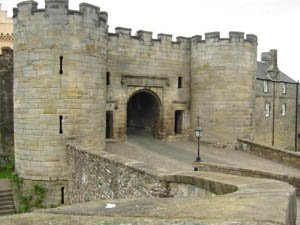 |
| |
| |
| |
| |
| |
| |
|
|
|
Chapels & Oratories
Throughout the medieval period Christianity of the form currently
in power was obligatory, with the interment exception of Jews. Almost
everyone was obliged to profess Christian belief and to act accordingly.
Only the most powerful nobles (like Frederick II) were able to express
disbelief without risking their lives.
The room in the castle called the Chapel was intended for prayer
and used by all members of the castle household. It was usually
close to the Great hall. It was often built two stories high, with
the nave divided horizontally. The Lord's family and dignitaries
sat in the upper part and the servants occupied the lower part of
the chapel
An Oratory was intended for use as a private chapel. It was a
room attached to the chapel that could be used for private prayer
by the Lord's family.
Today, the owners of Many Castles and Manor Houses will (for a
fee) allow people to get married in their Castle chapels with the
reception then taking place in the Castle.
Click
here for a list of Castles offering Weddings and Civil Partnerships
|
| The Chapel at Windsor Castle |
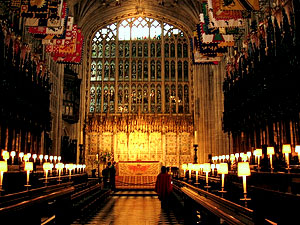 |
|
|
|
Cabinets and Boudoirs
Heating the main rooms in large palaces or mansions in the winter
was difficult, and small rooms were more comfortable. They also
offered more privacy from servants, other household members, and
visitors. Typically such a room would be for the use of a single
individual, so that a house might have two or more. Names varied:
cabinet, closet, study (from the Italian studiolo), or office.
A cabinet was one of a number of terms for a private room in the
castles and palaces of Early Modern Europe, serving as a study or
retreat, usually for a man. A cabinet would typically be furnished
with books and works of art, and sited adjacent to his bedchamber
(evolving into the equivalent of the Italian Renaissance studiolo
and the modern English studio). Such a room might be used as a study
or office, or just a sitting room.
In the Late Medieval period, such requirements for privacy had
been served by the solar of the English gentry house.
Cabinets could be used for small private meetings - for example
between the king and his ministers. Since the reign of King George
I, the Cabinet – which takes its name from the room – has been
the principal executive group of British government, and the term
has been adopted in most English-speaking countries. Phrases such
as "cabinet counsel", meaning advice given in private to the monarch,
occur from the late 16th century.
The word c cabinet in English was often used for strongrooms, or
treasure-stores - the tiny but exquisite Elizabethan tower strongroom
at Lacock Abbey might have been so called - but also in the wider
sense.
In Elizabethan England, such a private retreat would most likely
be termed a closet, the most recent in a series of developments
in which people of means found ways to withdraw from the public
life of the household as it was lived in the late medieval great
hall. This sense of "closet" has continued use in the term "closet
drama", which is a literary work in the form of theatre, intended
not to be mounted nor publicly presented, but to be read and visualised
in privacy. Two people in intimate private conversation are said
to be "closetted".
Much later closets were ideal locations for lavatories - which
thus became known as water closets or WCs.
There is a rare surviving cabinet or closet with its contents probably
little changed since the early 18th century at Ham House in Richmond,
London. It is less than ten feet square, and leads off from the
Long Gallery, which is well over a hundred feet long by about twenty
wide, giving a rather startling change in scale and atmosphere.
As is often the case (at Chatsworth House for example), it has an
excellent view of the front entrance to the house, so that comings
and goings can be discreetly observed. Most surviving large houses
or palaces, especially from before 1700, have such rooms, but (again
as at Chatsworth) they are very often not displayed to visitors.
Boudoirs
A boudoir is a lady's private bedroom, sitting room or dressing
room. The term derives from the French verb bouder, meaning "to
pout" - because the room was seen as a "pouting room".
Historically, the boudoir formed part of the private suite of rooms
of a lady, for bathing and dressing, adjacent to her bedchamber.
In this it was the female equivalent of the male cabinet.
In later periods, the boudoir was used as a private drawing room,
and was used for other activities, such as embroidery or entertaining
intimate acquaintances.
|
| Panelled Cabinet |
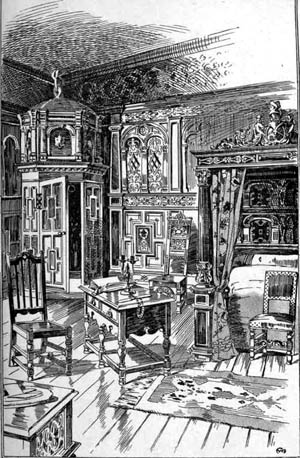 |
| |
| Cabinet room at 10 Downing Street |
 |
| |
| |
|
|
|
|
|
Storerooms, Undercrofts & Cellars
Casemate
A casemate was originally a vaulted chamber usually constructed
underneath the rampart. It was intended to be impenetrable and could
be used for sheltering troops or stores.
Place of Arms
The room in the castle called the Place of Arms was a large area
in a covered way, where troops could assemble.
Undercroft
An undercroft is traditionally a cellar or storage room, often
vaulted.
While some were used as simple storerooms, others were rented out
as shops. For example, the undercroft rooms at Myres Castle in Scotland
circa 1300 were used as the medieval kitchen and a range of stores.
The undercroft beneath the House of Lords in the Palace of Westminster
in London was rented out to the conspirators behind the Gunpowder
Plot in 1605.
Many early medieval undercrofts were vaulted or groined, such as
the vaulted chamber at Beverston Castle or the groined stores at
Myres Castle.
Undercrofts were commonly built in England and Scotland throughout
the thirteenth and early fourteenth centuries.
Buildings with historic examples
England
- Banqueting House, Palace of Whitehall, London
- Blakeney Guildhall, Blakeney, Norfolk
- Bradenstoke Abbey, Wiltshire
- Coventry Cathedral, Coventry, West Midlands
- Canterbury Cathedral, Canterbury, Kent
- Carlisle Cathedral, Carlisle, Cumbria
- Dragon Hall, Norwich, Norfolk
- Durham Castle, Undercroft, Durham
- Eastbridge Hospital, Canterbury, Kent
- Forde Abbey, Dorset.
- Fountains Abbey, North Yorkshire
- Jurnet's House, Norwich, Norfolk
- Moyse's Hall Museum, Bury St Edmunds, Suffolk
- Norton Priory, Runcorn, Cheshire
- Rufford Abbey, Nottinghamshire
- St Nicholas Priory, Exeter, Devon
- St Pancras Station, London
- Warwick Castle, Warwickshire
- Westminster Abbey, London
- Windsor Castle
- Wingfield Manor, Derbyshire
- York Minster, York, North Yorkshire
Other examples
- Dublin Castle, Dublin, Ireland
- Dundrennan Abbey, Dundrennan, Dumfries and Galloway, Scotland
- Cardiff Castle, Cardiff, Wales
- Castell Coch, Cardiff, Wales
|
|
|
|
|
|
Ice Houses
An ice-house was just that: a special insulated house to keep ice.
During the winter, ice and snow would be taken into the ice house
and packed with insulation, often straw or sawdust. It would remain
frozen for many months, often until the following winter, and could
be used as a source of ice during summer months. The main application
of the ice was the storage of perishable foods, but it could also
be used simply to cool drinks, or allow ice-cream and sorbet desserts
to be prepared.
Ice houses are found in ha-ha walls, house and stable basements,
woodland banks, and even open fields.
The most common designs involved underground chambers, usually
man-made, and built close to natural sources of winter ice such
as freshwater lakes. Ice houses varied in design depending on the
date and builder, but were mainly conical or rounded at the bottom
to hold melted ice. They usually had a drain to take away any water.
In some cases ponds were built nearby specifically to provide the
ice in winter.
The ice house was formally introduced to Britain around 1660, although
there are occasional examples surviving from the medieval period.
British ice houses were commonly brick lined, domed structures,
with most of their volume underground. The idea for formal ice houses
was brought to Britain by travellers who had seen similar arrangements
in Italy, where peasants collected ice from the mountains and used
it to keep food fresh inside caves.
  Usually
only castles and large manor houses had purpose-built buildings
to store ice. Many examples of ice houses exist in the UK some of
which have fallen into a poor state of repair. Good examples of
19th-century ice houses can be found at Ashton Court, Bristol, Grendon,
Warwickshire, and at Christchurch Mansion, Ipswich, Suffolk, Moggerhanger
Park, Bedfordshire Petworth House, Sussex, Danny House, Sussex,
Ayscoughfee Hall, Spalding, Rufford Abbey, and Eglinton Country
Park in Scotland and Parlington Hall in Yorkshire. Game larders
and venison larders were sometimes marked on ordnance survey maps
as ice houses. Usually
only castles and large manor houses had purpose-built buildings
to store ice. Many examples of ice houses exist in the UK some of
which have fallen into a poor state of repair. Good examples of
19th-century ice houses can be found at Ashton Court, Bristol, Grendon,
Warwickshire, and at Christchurch Mansion, Ipswich, Suffolk, Moggerhanger
Park, Bedfordshire Petworth House, Sussex, Danny House, Sussex,
Ayscoughfee Hall, Spalding, Rufford Abbey, and Eglinton Country
Park in Scotland and Parlington Hall in Yorkshire. Game larders
and venison larders were sometimes marked on ordnance survey maps
as ice houses.
The idea was old even in Medieval times. Ice houses originally
invented in Persia were buildings used to store ice throughout the
year. An inscription from 1700 BC in northwest Iran records the
construction of an icehouse, "which never before had any king built."
In China, archaeologists have found remains of ice pits from the
seventh century BC, and references suggest they were in use before
1100 BC. Alexander the Great around 300 BC stored snow in pits dug
for that purpose. In Rome in the third century AD, snow was imported
from the mountains, stored in straw-covered pits, and sold from
snow shops.
|
| The entrance to a medieval ice house at St. Germain's House
near Edinbugh |
 |
| |
| The icehouse at Coome Park undergoing restoration |
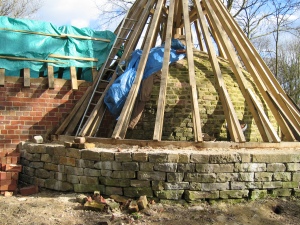 |
| |
| Rufford
Abbey Ice House 1 |
 |
| |
|
|
|
Dovecotes
A dovecote is a building intended to house pigeons or doves.
Dovecotes may be square or circular free-standing structures or
built into the end of a house or barn. They generally contain pigeonholes
for the birds to nest. Pigeons and doves were an important food
source historically in Western Europe and were kept for their eggs,
flesh, and dung.
In Medieval Europe, the possession of a dovecote was a symbol of
status and power and was regulated by law. Only nobles had this
special privilege known as droit de colombier.
Their location is chosen away from large trees that can house raptors
and shielded from prevailing winds and their construction obeys
a few safety rules: tight access doors and smooth walls with a protruding
band of stones (or other smooth surface) to prohibit the entry of
climbing predators such as rats, martens, and weasels. The exterior
facade was, if necessary, only evenly coated by a horizontal band,
in order to prevent their ascent.
Dovecote materials can be very varied and shape and dimension extremely
diverse:
- the square dovecote with quadruple vaulting: built before the
fifteenth century ( Roquetaillade Castle, Bordeaux) or Saint-Trojan
near Cognac)
- the cylindrical tower: fourteenth century to the sixteenth century,
it is covered with curved tiles, flat tiles, stone lauzes roofing
and occasionally with a dome of bricks. A window or skylight is
the only opening.
- the dovecote on stone or wooden pillars, cylindrical, hexagonal
or square;
- the hexagonal dovecote (like the dovecotes of the Royal Mail
at Sauzé-Vaussais);
- the square dovecote with flat roof tiles in the seventeenth
century and a slate roof in the eighteenth century;
- the lean-to structure against the sides of buildings.
- Inside a dovecote could be virtually empty (boulins being located
in the walls from bottom to top), the interior reduced to only
the structure of a rotating ladder, or "potence", allowing the
collection of eggs or squabs and maintenance.
The oldest known dovecotes are the fortified dovecotes of Upper
Egypt, and the domed dovecotes of Iran. In the dry regions, the
droppings were in great demand and were collected on uniformly cleaned
braids.
Dovecotes were built by the Romans, who knew them as Columbaria.
They seem to have introduced them to Gaul. The presence of dovecotes
is not noted in France before the Roman invasion of Gaul by Caesar.
The pigeon farm was then a passion in Rome: the Roman columbarium
, generally round, had its interior covered with a white coating
of marble powder. Varro, Columella and Pliny the Elder wrote works
on pigeon farms and dovecote construction.
Dovecotes of France
The French word for dovecote is pigeonnier or colombier. In some
French provinces, especially Normandy, dovecotes were built of wood
in a very stylised way. Stone was the other popular building material
for these old dovecotes. These stone structures were usually built
in circular, square and occasionally octagonal form. Some of the
medieval French abbeys had very large stone dovecotes on their grounds.
In Brittany the dovecote was sometimes built directly into the
upper walls of the farmhouse or manor-house. In rare cases, it was
built into the upper gallery of the lookout tower (for example at
the Toul-an-Gollet manor in Plesidy, Brittany). Dovecotes of this
type are called tour-fuie in French.
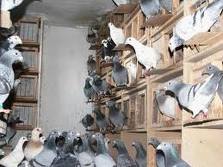  Some
of the larger châteaux-forts such as the Château de
Suscinio in Morbihan, still have a complete dovecote standing on
the grounds, outside the moat and walls of the castle. Some
of the larger châteaux-forts such as the Château de
Suscinio in Morbihan, still have a complete dovecote standing on
the grounds, outside the moat and walls of the castle.
The dovecote interior, the space granted to the pigeons, is divided
into a number of boulins (pigeon holes). Each boulin is the lodging
of a pair of pigeons. These boulins can be in rock, brick or cob
(adobe) and installed at the time of the construction of the dovecote
or be in pottery (jars lying sideways, flat tiles, etc.), in braided
wicker in the form of a basket or of a nest. It is the number of
boulins that indicates the capacity of the dovecote. The one at
the Château d'Aulnay with its 2,000 boulins and the one at
Port-d'Envaux with its 2,400 boulins of baked earth are among the
largest ones in France.
In the Middle Ages, particularly in France, the possession of a
colombier à pied (dovecote on the ground accessible by foot), constructed
separately from the corps de logis of the manor-house (having boulins
from the top down), was a privilege of the seigneurial lord. He
was granted permission by his overlord to build a dovecote or two
on his estate lands. For the other constructions, the dovecote rights
(droit de colombier) varied according to the provinces. They had
to be in proportion to the importance of the property, placed in
a floor above a henhouse, a kennel, a bread oven, even a wine cellar.
Generally the aviaries were integrated into a stable, a barn or
a shed, and were permitted to use no more than 2.5 hectares of arable
land.
Although they produced an excellent fertiliser (known as colombine),
the lord's pigeons were often seen as a nuisance by the nearby peasant
farmers, in particular at the time of sowing of new crops. In numerous
regions where the right to possess a dovecote was reserved solely
for the nobility , the complaint rolls very frequently recorded
formal requests for the suppression of this privilege and a law
for its abolition, which was finally ratified on 4 August 1789 in
France.
Many ancient manors in France have a dovecote (still standing or
in ruins) in one section of the manorial enclosure or in nearby
fields.
The Romans may have introduced dovecotes or columbaria to Britain
since pigeon holes have been found in Roman ruins at Caerwent. However
it is believed that doves were not commonly kept there until after
the Norman invasion. The earliest known examples of dove-keeping
occur in Norman castles of the 12th century (for example, at Rochester
Castle, Kent, where nest-holes can be seen in the keep), and documentary
references also begin in the 12th century. The earliest surviving,
definitely-dated free-standing dovecote in this country was built
in 1326 at Garway in Herefordshire.
Many ancient manors in the United Kingdom have a dovecote (still
standing or in ruins) in one section of the manorial enclosure or
in nearby fields.
Early purpose-built dovecotes in Scotland are of a "beehive" shape,
circular in plan and tapering up to a domed roof with a circular
opening at the top. In the late 16th century they were superseded
by the "lectern" type, rectangular with a monopitch roof sloping
fairly steeply in a suitable direction. In Scotland a dovecote is
known as a Doocot.
Phantassie Doocot is an unusual example of the beehive type topped
with a monopitch roof, and Finavon Doocot of the lectern type is
the largest doocot in Scotland, with 2,400 nesting boxes. Doocots
were built well into the 18th century in increasingly decorative
forms, then the need for them died out though some continued to
be incorporated into farm buildings as ornamental features. The
20th century saw a revival of doocot construction by pigeon fanciers,
and dramatic towers clad in black or green painted corrugated iron
can still be found on wasteland near housing estates in Glasgow
and Edinburgh.
|
| Colombier at Manoir d'Ango near Dieppe |
 |
| |
| Schematic showing the interior of a dovecote |
 |
| |
| Interior of Dovecote at Penmon Priory |
 |
| |
| Dovecote at Nymans Gardens, West Sussex, England |
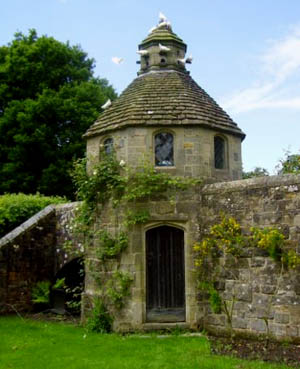 |
| |
| Ross Doocot |
 |
|
|
|
Apartments
Apartments are not modern inventions. Great castles were often
divided into apartments, each apartment belonging to an important
resident - for example the Lord's widowed mother, his brothers and
sisters, and visiting dignitaries.
This model, once common in all great houses, survives among British
royalty. Most royal palaces are divided into apartments, each belonging
to a senior member of the Royal Family.
|
| Kensington Palace - the official residence of The Duke and
Duchess of Gloucester; the Duke and Duchess of Kent; and Prince
and Princess Michael of Kent. |
 |
| |
|
|
|
|
|
More on Life in a Medieval Castle
Introduction
to Life in a Medieval Castle
Rooms
in a Medieval Castle
Officers
& Servants in a Medieval Castle
Medieval
Clothing
Medieval
Food & Cooking
Medieval
Drinks
Medieval
Gardens
Medieval
Warfare:
Medieval
Taxes
Medieval
Games & Pastimes
The
Feudal System
Commendation
Desmenes
Rivers
& Fishponds
Mills:
Windmills
and Water
Mills
|
|
The Great Hall at Christ Church College,
Oxford
|
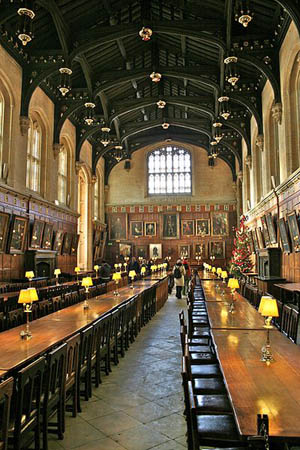 |
| |
|
Falconer
|
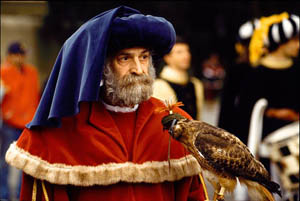 |
| |
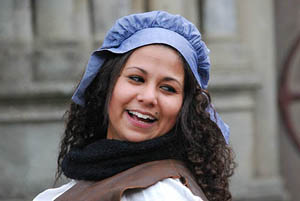 |
| |
|
A baker with his assistant. As seen in the
illustration, round loaves were among the most common.
|
 |
| |
| |
| |
место преступления
.
| |


 Once you enter that single door into the keep you come into a room called the disarming room. This is where all visitors would give up their weapons. We can't have people walking around with weapons inside the keep. You just never know who to trust.
Once you enter that single door into the keep you come into a room called the disarming room. This is where all visitors would give up their weapons. We can't have people walking around with weapons inside the keep. You just never know who to trust.  And this is that massive main door too the keep. It is very thick and solid. This actual door and lock are about 250 years old. The key to this door is about a foot in size. Pretty solid stuff. We are standing right inside the disarming room.
And this is that massive main door too the keep. It is very thick and solid. This actual door and lock are about 250 years old. The key to this door is about a foot in size. Pretty solid stuff. We are standing right inside the disarming room. There are various rooms in the keep and they look like this. The wooden floor is the same as it would have been hundreds of years ago.
There are various rooms in the keep and they look like this. The wooden floor is the same as it would have been hundreds of years ago.  Another fascinating defense measure inside the keep was the way the stairwells were made. They would have a clockwise rotation so defenders of the keep could easily use their right hand sword hand. Attackers trying to go up the stairs would have their sword hand agains the inner wall. That made it difficult for them to swing their swords.
Another fascinating defense measure inside the keep was the way the stairwells were made. They would have a clockwise rotation so defenders of the keep could easily use their right hand sword hand. Attackers trying to go up the stairs would have their sword hand agains the inner wall. That made it difficult for them to swing their swords. Now, this is a little difficult to see but in that alcove on the left there is a hole in the bottom. That is the toilet chute! Yup, they had to take care of business in the keep. And that chute goes all the way down to a room in the bottom.
Now, this is a little difficult to see but in that alcove on the left there is a hole in the bottom. That is the toilet chute! Yup, they had to take care of business in the keep. And that chute goes all the way down to a room in the bottom.  Here is a fireplace inside the castle main room. And the big thing about this is that it was added centuries after the keep was first built! Yup, it was a marvel of an upgrade and renovation! Until then this keep was very cold.
Here is a fireplace inside the castle main room. And the big thing about this is that it was added centuries after the keep was first built! Yup, it was a marvel of an upgrade and renovation! Until then this keep was very cold.  And here is a look up through the fireplace air chute. It is called a fumarelli and it curves and twists on its way up to bring the smoke out. But the curving and twisting was to prohibit rain from coming straight down and into the keep , putting out the fire.
And here is a look up through the fireplace air chute. It is called a fumarelli and it curves and twists on its way up to bring the smoke out. But the curving and twisting was to prohibit rain from coming straight down and into the keep , putting out the fire. 

